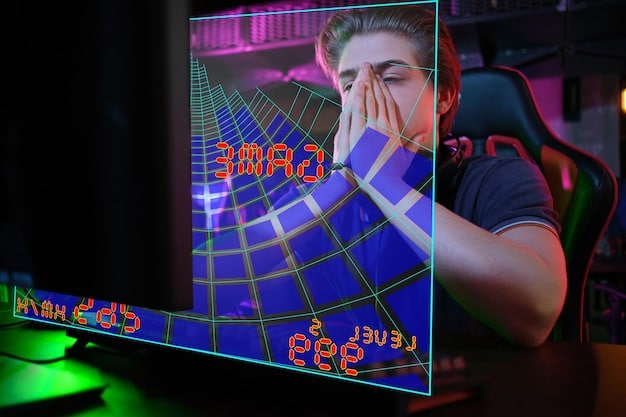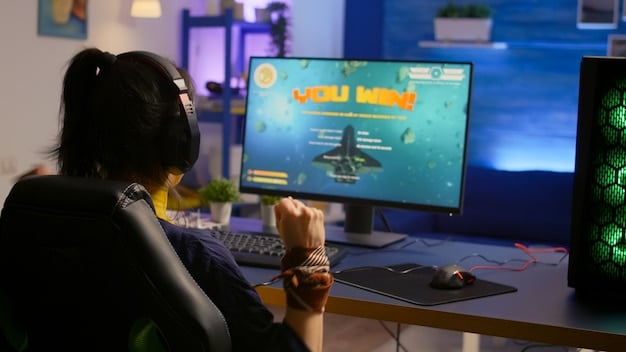Valve Anti-Cheat: Effective for US CS:GO Pros?

Valve’s Anti-Cheat System (VAC) continues to be a hot topic among US CS:GO pros, with debates raging about its effectiveness in combating cheaters and maintaining fair gameplay in competitive matches.
The integrity of competitive gaming hinges on effective anti-cheat measures, and for US Counter-Strike: Global Offensive (CS:GO) professionals, the effectiveness of Valve’s Anti-Cheat (VAC) system is a perpetual concern.
Valve Anti-Cheat (VAC): An Overview
Valve Anti-Cheat, commonly known as VAC, is an anti-cheat system developed by Valve as a component of the Steam platform. Its primary objective is to detect and prevent cheating in online multiplayer games, including CS:GO. The system operates by scanning users’ computers for known cheat signatures and patterns.
How VAC Works
VAC functions as a background process, continuously monitoring the game files and system processes of players connected to VAC-secured servers. When it detects a known cheat, a VAC ban is issued, preventing the player from participating in VAC-secured servers for that game. While VAC has been a mainstay in combating cheating, its effectiveness is constantly debated within the CS:GO community.
The Perception of VAC Among Pros
Many professional CS:GO players in the US have voiced mixed feelings about VAC. Some believe it’s a necessary tool that catches a significant number of cheaters, while others argue that it’s often too slow and misses more sophisticated cheats. This ongoing debate underscores the complexities of anti-cheat technologies in the competitive gaming world.

- Continuous Scanning: VAC is designed to continuously scan players’ systems for unauthorized software, adding a layer of security to online matches.
- Server-Side Enforcement: VAC bans are enforced on the server side, preventing confirmed cheaters from joining VAC-secured servers.
- Delayed Bans: VAC bans are often delayed to prevent cheat developers from quickly identifying and circumventing the detection methods.
In conclusion, Valve Anti-Cheat is a critical element in the fight against cheating in CS:GO, yet its effectiveness is a contentious issue among professional players in the US, highlighting the complex challenges of maintaining fair gameplay.
The Evolving Landscape of Cheating in CS:GO
Cheating is an ever-present challenge in online multiplayer games, and CS:GO is no exception. As VAC evolves, so do the methods used by cheaters. Understanding the types of cheats and how they’re evolving is crucial for assessing the overall effectiveness of anti-cheat systems.
Common Types of Cheats
Cheats range from simple aim assists to complex wallhacks and scripting tools. Aim assists provide players with improved aiming accuracy, while wallhacks allow them to see opponents through walls. Scripting tools can automate certain in-game actions, providing unfair advantages. The prevalence of these cheats is a constant source of frustration for legitimate players.
The Arms Race Between Cheat Developers and VAC
Cheat developers are always looking for ways to circumvent VAC’s detection methods, leading to an ongoing arms race between them and Valve. When a new type of cheat emerges, VAC must adapt to detect and counteract it. This continuous cycle highlights the need for innovative and adaptable anti-cheat solutions.
- Machine Learning: Implementing advanced machine learning algorithms can help detect unusual gameplay patterns, a significant leap in cheat detection.
- Behavioral Analysis: Analyzing player behavior and statistics can identify anomalies that indicate cheating.
- Heuristic Detection: Focusing on heuristic detection methods can anticipate and counter new and evolving cheat techniques.
In summary, the constant evolution of cheating methods in CS:GO necessitates a proactive and adaptive approach to anti-cheat systems, as cheat developers continually seek vulnerabilities and innovative ways to bypass existing protections. As such innovations arise, discussion is generated regarding the value of Valve’s Anti-Cheat System Update and whether change is happening fast enough or soon enough.

Concerns and Criticisms from US CS:GO Pros
American CS:GO pros have often voiced their opinions and critiques regarding VAC, highlighting instances where they feel the system has fallen short. These perspectives offer invaluable insights into the system’s limitations and potential areas for improvement.
Instances of High-Profile Cheating Accusations
Several high-profile incidents have fueled skepticism about VAC’s effectiveness. Cases where professional players have been accused of cheating, despite VAC’s presence, raise questions about the system’s ability to detect sophisticated cheats used at the highest levels of competition. These accusations can have a significant impact on the integrity of the game.
The Impact on Match Integrity
Concerns about cheating directly impact the perceived integrity of matches. When pros and viewers alike question the fairness of the competition, it erodes trust in the game and its competitive scene. Maintaining match integrity is essential for ensuring the continued success of CS:GO esports.
- Improved Detection: Implementing more advanced detection techniques to catch subtle forms of cheating can lead to increased public and professional satisfaction.
- Faster Response Times: Addressing instances of cheating quickly and transparently is crucial for maintaining trust.
- Community Feedback: Engaging with the professional community and incorporating their feedback can improve VAC’s overall effectiveness and reputation.
To summarize, US CS:GO pros’ concerns and criticisms emphasize the importance of transparency, responsiveness, and continuous improvement in anti-cheat systems to maintain match integrity and player trust.
Valve’s Efforts to Improve VAC
Valve has consistently worked on improving VAC to combat the growing sophistication of cheating techniques. These efforts include updates to the detection algorithms, as well as the introduction of new anti-cheat measures. Understanding these efforts provides a more complete picture of VAC’s evolution and potential effectiveness.
Recent Updates and Changes
Valve regularly releases updates to VAC, incorporating new detection methods and addressing vulnerabilities that cheat developers have exploited. These updates are often kept secret to prevent cheat developers from quickly adapting to them. Staying up-to-date with these changes is critical for understanding VAC’s current capabilities.
The Role of Machine Learning and AI
Machine learning and artificial intelligence are playing an increasingly important role in VAC’s capabilities. These technologies can analyze vast amounts of gameplay data to identify patterns and anomalies that indicate cheating, even if those cheats have not been previously detected by traditional methods. Integrating AI and machine learning into VAC represents a significant advancement in anti-cheat technology.
- Regular Audits: Conducting regular audits of VAC’s performance and effectiveness can help identify areas where improvements are needed.
- Collaboration: Collaborating with third-party anti-cheat providers can bring new perspectives and technologies to VAC.
- Transparency: Providing more transparency about the types of cheats that VAC can detect can help reassure the community and deter potential cheaters.
In conclusion, Valve’s continuous efforts to improve VAC, through updates, artificial intelligence, and other advanced technologies, demonstrate a commitment to combating cheating, which can significantly influence the perspectives of US CS:GO pros.
Alternative Anti-Cheat Solutions in Esports
While VAC is the primary anti-cheat system in CS:GO, other esports platforms and leagues employ alternative solutions to ensure fair play. These alternatives may offer different approaches and levels of effectiveness, providing insights into potential improvements for VAC.
Third-Party Anti-Cheat Systems (e.g., FACEIT, ESEA)
Platforms such as FACEIT and ESEA use their own anti-cheat systems, which are often considered more effective by professional players. These systems typically include client-side software with more stringent detection methods and stricter enforcement policies. Comparing these systems with VAC can highlight potential areas for improvement.
The Pros and Cons of Client-Side Anti-Cheat
Client-side anti-cheat systems run directly on players’ computers, allowing for more thorough monitoring and detection capabilities. However, they also raise concerns about privacy and system performance. Balancing the benefits of client-side anti-cheat with these concerns is a key challenge for anti-cheat developers.
- Custom Detection Methods: Tailoring anti-cheat systems to the specific gameplay mechanics of CS:GO.
- Enhanced Monitoring: Employing more advanced monitoring techniques to detect subtle forms of cheating.
- Hardware Scans: Considering the use of hardware scans with appropriate software to detect cheating behaviors.
In summary, the existence and relative success of third-party anti-cheat systems underscore the ongoing quest for more effective methods to combat cheating in CS:GO and other esports, underscoring the Valve’s Anti-Cheat System Update.
The Future of Anti-Cheat in CS:GO
The future of anti-cheat in CS:GO likely involves a combination of innovative technologies and collaborative efforts between developers, players, and the community. Addressing the challenges of cheating will require a multi-faceted approach that adapts to the evolving landscape of online gaming.
Potential Innovations and Technologies
Emerging technologies such as blockchain, advanced AI, and behavioral biometrics may offer new ways to combat cheating. Blockchain can provide transparent and tamper-proof records of player statistics, while AI can detect subtle patterns of suspicious behavior. Behavioral biometrics can identify players based on their unique movements and actions, making it harder for cheaters to impersonate legitimate players. Embracing these innovations could revolutionize anti-cheat measures.
The Importance of Community Reporting and Collaboration
Community reporting plays a crucial role in identifying and addressing potential cheaters. Encouraging players to report suspicious behavior and providing them with the tools to do so effectively can help supplement VAC’s automated detection methods. Collaboration between Valve, professional players, and the broader CS:GO community can lead to more effective anti-cheat strategies. When players are able to contribute directly and witness results from these reports, a collaborative community grows and more players report suspicious activity.
- Enhanced Reporting Tools: Improving the tools available to players for reporting suspected cheating activity.
- Developer Communication: Maintaining open lines of communication between anti-cheat developers and the community to foster collaboration.
- Transparent Communication: Sharing information about VAC’s performance and planned improvements with the community.
In conclusion, the future of anti-cheat in CS:GO hinges on embracing innovation, fostering collaboration, and empowering the community to play an active role in maintaining fair gameplay.
| Key Point | Brief Description |
|---|---|
| 🛡️ VAC Overview | Valve Anti-Cheat system’s role in detecting and banning cheaters in CS:GO. |
| 🎮 Cheating Evolution | Constant adaptation of cheats and VAC’s responses. |
| 🗣️ Pro Concerns | Criticism from US CS:GO pros on VAC’s effectiveness. |
| 🚀 Future Tech | Potential for AI and blockchain in anti-cheat measures. |
What is Valve Anti-Cheat (VAC)?
▼
Valve Anti-Cheat (VAC) is an automated system designed to detect cheats installed on users’ computers. If VAC detects a cheat, it issues a ban, preventing the player from connecting to VAC-secured servers.
Are US CS:GO pros satisfied with VAC?
▼
US CS:GO pros have mixed opinions on VAC, with some finding it effective and others criticizing its slow response and inability to detect sophisticated cheats.
What types of cheats are prevalent in CS:GO?
▼
Common cheats in CS:GO include aim assists, wallhacks, and scripting tools, which provide unfair advantages and disrupt fair gameplay.
How is Valve working to improve VAC?
▼
Valve is continually updating VAC with new detection methods, machine learning, and AI technologies to combat the evolving landscape of cheating.
Are there alternative anti-cheat solutions in esports?
▼
Yes, platforms like FACEIT and ESEA use third-party anti-cheat systems that often employ client-side software for more thorough monitoring and stricter enforcement.
Conclusion
In conclusion, while Valve’s Anti-Cheat system remains a vital component in maintaining fair play, the concerns voiced by US CS:GO pros highlight the ongoing challenges and the need for continuous improvements and innovations in anti-cheat technologies to ensure the integrity of competitive CS:GO.





